Miramichi, New Brunswick 作者: 来源: 发布时间:2021-12-02
I.Population and Area
-Area
Land: 179.47 km2 (69.29 sq mi)
-Population (2016)
Total: 17,537
Density: 97.7/km2 (253/sq mi)
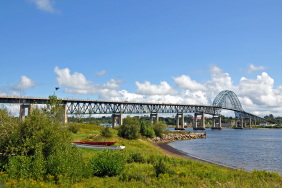
II.Natural Geography (environment and resources)
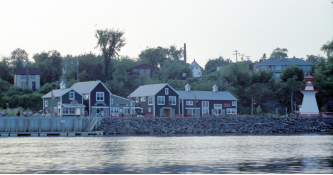
-Miramichi is the largest city in northern New Brunswick, Canada. It is situated at the mouth of the Miramichi River where it enters Miramichi Bay. The Miramichi Valley is the second longest valley in New Brunswick, after the Saint John River Valley.
-The city of Miramichi was formed in 1995 through the forced amalgamation of two towns, Newcastle and Chatham, and several smaller communities, including Douglastown, Loggieville, and Nelson. Also the local service districts of Nordin, Moorefield, Chatham Head, and Douglasfield. The amalgamation also included portions of the former local service district of Ferry Road-Russellville (Now separated and merged with Lower Newcastle-Russellville) and portions of Chatham Parish, Glenelg Parish and Nelson Parish.
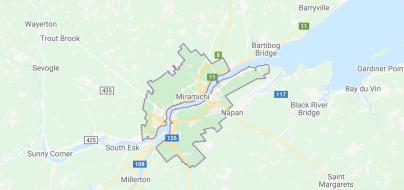
-Transportation
-Roads
Centennial Bridge
Miramichi has good highway connections to other major centres in New Brunswick offered via Highways 8 (west to Fredericton; north to Bathurst and Campbellton) and 11 (south to Moncton, Prince Edward Island and Nova Scotia). The Plaster Rock – Renous highway (Route 108) offers the quickest connection to major centres in Quebec, Ontario, and points west.
For many years, the only bridge at Miramichi was a narrow, historic crossing called the Morrissy Bridge, at Newcastle. Ferry service facilitated crossings at Chatham and Loggieville. In the late 1960s the Centennial Bridge was completed at Chatham, greatly improving north-south transit across the river. The Miramichi Bridge at Newcastle opened in the late 1990s.
-Bus
-Miramichi Transit also operates local bus service within the city.
-Water
The towns of Chatham and Newcastle were formerly important ports for northeastern New Brunswick. Dredging, however, was necessary to maintain a deep enough channel for most ships to cross between the barrier dune islands at the mouth of Miramichi Bay. Ocean-going ships entering the port must have a shallow draft, and must navigate the ancient, meandering course of the drowned Miramichi River channel through the inner Bay.
Miramichi Port Committee Inc. (MPCI) owns and operates the marine terminal situated close below the Morrisey Bridge in Miramichi West (the former town of Newcastle). The focus of MPCI is to provide logistics to the forestry sector. MPCI officially commenced operation in 2004. The site contains approximately 21,625 m2 (5.34 acres) of property, with a berthage length of 313 m and a depth of 9 m. Two unheated storage sheds are located on the property containing 10,300 m2 and 2325 m2 of enclosed storage area. There is an open storage area of 9000 square metres.
-Rail
The Canadian National Railway (CN) northern line between Moncton and Campbellton passes through Miramichi. Miramichi was served by the New Brunswick East Coast Railway (NBECR) until it was purchased by CN in 2008. Via Rail offers passenger service on this line at the Miramichi railway station via the Ocean train to Montreal and Halifax.
-Air
Miramichi is located within a 90-minute drive of two international airports (Fredericton International Airport, Greater Moncton International Airport) with scheduled domestic and international flights. In addition the Miramichi Airport Commission operates the Miramichi Airport (YCH) on the former site of CFB Chatham.
III.ECONOMY
-Average Hourly Rate in Miramichi, New Brunswick: C$17.34
-The average salary in Miramichi, New Brunswick is C$17.34. Trends in wages decreased by -100.0 percent in Q1 2020. The cost of living in Miramichi, New Brunswick is 100 percent higher than the national average. The most popular occupations in Miramichi, New Brunswick are Personal Support Worker (PSW), Early Childhood Educator (ECE), and Meat Cutter which pay between C$11.81 and C$30.61 per year. The most popular employers in Miramichi, New Brunswick are City of Miramichi, Group Jean Coutu Inc, and Sobey's Inc..
-Website: https://www.payscale.com/research/CA/Location=Miramichi-New-Brunswick/Salary
IV.Industrial Characteristics
-The Miramichi area’s economy is primarily focused on mining, fishing and forestry. Other sectors include tourism, customer contact centres, manufacturing, and the provincial and federal government. The service sector is the city's largest employer. The region has recently experienced the closure of several wood mills causing many residents to migrate west. Since the shale gas boom in Alberta, many Miramichi residents split their time between the oil fields and Miramichi.
-The Repap paper mill (between the Anderson and Miramichi Bridges) was purchased by UPM in 2000, and was later closed in 2007 because of economic pressures in the North American forest industry and subsequently demolished. A closed Weyerhauser OSB mill at Morrison Cove was subsequently purchased by Arbec, a Quebec-based company and the mill re-opened in 2013 producing OSB products.
V.Attractions
1.RITCHIE WHARF PARK
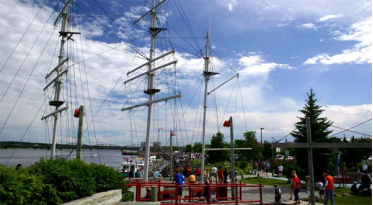
-‘Shipbuilding’ is the theme of this charming public park. While this very waterfront was once a thriving shipbuilding industry, today it is a place where your children can have fun in the nautically themed playground. They’ll love to play and get wet on the splash pad, then sit down for a scoop (or 3) of ice cream! You’ll appreciate the boardwalk’s shops, artists’ gallery and restaurants.
-You can dock or launch your boat from Ritchie Wharf Park, or embark on an exciting boat tour or charter. Enjoy live entertainment most evenings and Sunday afternoons. Don’t miss the many special events happening throughout the summer!
-Tel.: 506-623-2200
-Toll-Free: 800-459-3131
-Website: https://www.tourismnewbrunswick.ca/Products/R/Ritchie-Wharf-Park/
2.MIDDLE ISLAND IRISH HISTORICAL PARK
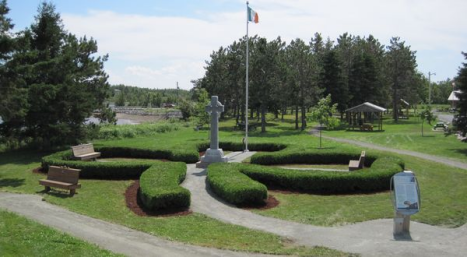
-Middle Island in Miramichi River was a quarantine station in the 19th century, specifically for Irish immigrants fleeing the Irish Potato Famine. Many perished while on the Island. In 1873 it was declared a permanent quarantine station by the Federal Government until 1948.
-Immerse yourself in the history while walking along sandy beaches and scenic trails; visit the Celtic Cross, Interpretive Centre, amphitheatre, the Captain’s Galley Restaurant, picnic areas and interpretive panels.
-Tel.: 506-773-7505
-Off-season: 506-424-7523
-Address: https://www.tourismnewbrunswick.ca/Products/M/Middle-Island-Irish-Historical-Park/
3.Miramichi River
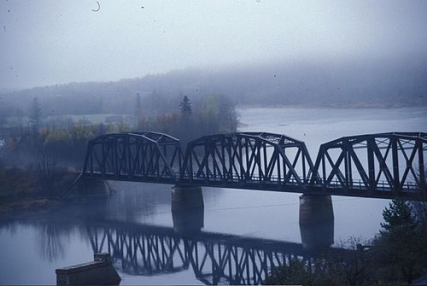
-The Miramichi River /ˌmɪrəmɪˈʃiː/ is a river located in the east-central part of New Brunswick, Canada.The river drains into Miramichi Bay in the Gulf of St. Lawrence. The name may have been derived from the Montagnais words "Maissimeu Assi" (meaning Mi'kmaq Land), and it is today the namesake of the Miramichi Herald at the Canadian Heraldic Authority.
-The Miramichi River watershed drains a territory comprising one-quarter of New Brunswick's territory, measuring approximately 13,000 km² of which 300 km² is an estuarine environment on the inner part of Miramichi Bay. The watershed roughly corresponds to Northumberland County, but also includes sections of Victoria County, Carleton County, and York County and smaller parts of Gloucester County and Sunbury County.
-The Miramichi River meander length measures approximately 250 km and comprises two important branches, the Southwest Miramichi River and the Northwest Miramichi River, each having their respective tributaries. Nearly every bend in the river, from Push and Be Damned Rapids to the Turnip Patch has a distinctive name, reflecting the importance of the river to fishermen, canoeists, and lumbermen. Tides reach upriver in the Miramichi system to Sunny Corner on the Northwest Miramichi and to Renous-Quarryville on the Southwest Miramichi — a distance of approximately 70 km inland from the Gulf of St. Lawrence. The two branches combine at Newcastle where the river becomes navigable to ocean-going vessels.
-The estuarine portion of the Miramichi River downriver from Newcastle in the city of Miramichi flows through a drowned river valley. Sea level rise in Miramichi Bay has flooded the mouth of the Miramichi River with saltwater. The estuary comprises the inner portion of Miramichi Bay and is protected from ocean storms in the Gulf of St. Lawrence by barrier islands. The estuary is significant in that it is a highly productive ecosystem, despite its relatively small size. The estuary receives the freshwater discharge from the Miramichi River and its tributaries, mixing with organic materials from the surrounding shorelines and the saltwater inundation from the Gulf of St. Lawrence, itself an estuary and the largest on the planet.
-The estuary is a highly dynamic environment, ranging from the high outflows of freshwater during the spring freshet, to the low outflow and rising saltwater content during the summer period, to fall ocean storms and nor'easters that reshape the barrier islands and the old river channel that forms the navigation channel for ocean-going ships heading to ports at Chatham and Newcastle, to the winter covering of sea ice that encases the entire estuary. The inner bay measures only 4 m deep on average, with the navigation channel measuring only 6–10 m, resulting in significant warming of estuarine waters during the summer months. The diurnal tide cycle ranges only 1 m on average.
-Website: https://mynewbrunswick.ca/miramichi-river/
VI.History
-Mi'kmaq and French communities (before 1765)
-Long prior to European settlement, the Miramichi region was home to members of the Mi'kmaq first nation. For the Mi'kmaq, Beaubears Island, at the junction of the Northwest and Main Southwest branches of the Miramichi River was a natural meeting point.
-Following the European discovery of the Americas, the Miramichi became part of the French colony of Acadia. About 1648, Nicolas Denys, Sieur de Fronsac, established a fort and trading post, Fort Fronsac, on the Miramichi. This establishment was apparently constructed "on the North side of the Miramichi, at the forks of the river". According to W.F.Ganong, a Recollet Mission was established in 1686 on the Miramichi "in Nelson", "probably near Beaubear's Island".
-Nicolas Denys' son, Richard Denys, was placed in charge of the fort and trading post, and in 1688 Richard states, "Miramichi is the principal place of my residence", and describes his establishment as including about a dozen French and more than 500 indigenous inhabitants. In 1691 Richard died at sea; the post declined.
-The following account from the Dictionary of Miramichi Biography describes in greater detail the extent of the Denys' Miramichi base:
-"The domain of Nicholas Denys, governor of Acadia, extended along the southerly side of the Gulf of St Lawrence, from Miscou Island to Cape Breton. It may have included a trading post at Miramichi in the 1640s, but the first extensive French establishment on the river was that of Denys's son Richard Denys. He began to cultivate land along the Miramichi in 1684. In 1688 he had a fort with gun emplacements, a house built of freestone, and a storehouse. There were three French families at the fort, and he had men employed catching fish. Nearby there were approximately eighty Micmac wigwams.
-"The site of Denys's establishment, which is considered to have been on the north side of the Miramichi opposite the Point - that is, near the former pulp mill site in Newcastle - was abandoned by 1691. In August of that year, when he was thirty-seven years old, Denys set sail for Quebec in the ship Saint-François-Xavier, which was never heard of again. His estate passed to his widow in 1694 and was still owned by members of the family in Quebec in the 1750s."
-By about 1740 French villages were well established on Miramichi Bay at Bay du Vin and Neguac. In the current city of Miramichi, a larger village existed at Canadian Point, and a town comprising 200 houses, a chapel, and provision stores occupied "Beaubear's Point". The French maintained batteries of guns at the east end of Beaubears Island and at French Fort Cove.
-French and Indian War
-Camp d'Espérance Memorial at Wilson's Point (IR Walker 2007)
-The French and Indian War erupted in 1754. During the war many Acadian homes were destroyed by the British, and their residents were deported (see the Expulsion of the Acadians).
-In 1757 the French general, Charles Deschamps de Boishébert et de Raffetot attempted to evade British troops in the Saint John River Valley and the Bay of Fundy, by leading 900 French refugees up the northeast coast of New Brunswick to Miramichi, establishing a camp, "Camp de l’Espérance", on Beaubears Island. After the Siege of Louisbourg (1758), Boishebert led a group of Acadians from St. Peter's, Nova Scotia to Miramichi. Over 200 of the refugees died at the camp.
-On 13 August 1758 French officer Boishebert left Miramichi with 400 soldiers, including Acadians from Port Toulouse, for Fort St George (Thomaston, Maine). His detachment reached there on 9 September but was caught in an ambush and had to withdraw. They then went on to raid Friendship, Maine, where British settlers were killed and others taken prisoner. This was Boishébert’s last Acadian expedition. From there, Boishebert and the Acadians went to Quebec and fought in the Battle of Quebec (1759).
-In September 1758 Colonel James Murray reported spending two days in Miramichi Bay during the Gulf of St. Lawrence Campaign looking unsuccessfully for Acadians, but destroying anything he found. This included burning the first stone church built in New Brunswick (at the site of the present-day community of Burnt Church). Murray did not sail as far west as Beaubear's Island.
-Most of the surviving Beaubear's Island refugees soon left the Miramichi, seeking refuge in Quebec. Some Acadians, however, remained and escaped British attempts at deportation. They eventually established (or re-established) a host of small Acadian communities along the northern and eastern coasts of present-day New Brunswick.
-Scottish and Loyalist immigration (1765–1800)
-Wilson's Point historic site
-The French were defeated at Quebec (1759) and Montreal (1760), and the remaining Miramichi settlement was subsequently burned to the ground by British Commodore John Byron (Foul-Weather Jack) in 1760. The French North American colonies (apart from Saint Pierre and Miquelon) were ceded to the British in the 1763 Treaty of Paris. The Miramichi thus became a part of the British colony of Nova Scotia, and later New Brunswick. Benjamin Marston, a surveyor and the first sheriff, reported in 1785 that "a considerable French Village" had existed on Wilson's Point (adjacent to Beaubear's Island, the present-day site of the Enclosure).
-Although they were clearly preceded by the Mi'kmaq and Acadian peoples, credit for the first permanent white settlement at Miramichi is often granted to Scottish settlers, led by William Davidson. William Davidson (a.k.a. John Godsman) and John Cort had obtained a large grant encompassing much of the Miramichi region in 1765, and promoted the area in both Scotland and New England as a new home to potential settlers.
-American Revolution and Battle at Miramichi (1779)
-At the beginning of the American Revolution the Mi’kmaq and Maliseet were supportive of the Americans against the British. They participated in the Maugerville Rebellion and the Battle of Fort Cumberland in 1776. Three years later, in June 1779, Mi’kmaq in the Miramichi attacked and plundered some of the British in the area. The following month, British Captain Augustus Harvey, in command of HMS Viper, arrived in the area and battled with the Mi’kmaq. One Mi’kmaq was killed and 16 were taken prisoner to Quebec. The prisoners were eventually brought to Halifax, where they were later released upon signing an oath of allegiance to the British Crown on 28 July 1779.
-After the battle, Davidson temporarily found refuge along the Saint John River. A subsequent treaty signed 22 September 1779 ensured a more peaceful coexistence. Following the American Revolution some loyalist families moved to Miramichi. Davidson's original grant was revoked, and competition for the best lands escalated tensions between the early Scottish and new loyalist settlers.
-Great Miramichi Fire of 1825
-Main article: Miramichi Fire
-In 1825, a large forest fire, among the worst in recorded history of North America, devastated a number of communities in northern New Brunswick.
-Irish immigration (1815–1850)
-The Irish began arriving in Miramichi in numbers after 1815 at the end of the Napoleonic War and with a few exceptions ceased coming to the area before the great Irish famine of 1847. They came to the area voluntarily to better their lives. Contrary to prevailing belief, not all of them were Catholic though very few Protestants among them identified openly as Irish and most of their descendants in Miramichi do not do so even to this day. Most arrived form the ports of Belfast and Cork each of which had strong commercial ties with Miramichi. Like the Scots they came on timber ships as individuals or in small family groups and the average age upon arrival was twenty-four. There was some chain emigration whereby additional family members joined the emigrant later but this was minimal. The Miramichi River valley was not settled by large transplantations of Scottish clans or large scale movements of starving and evicted Irish. Though there are one or two interesting exceptions. In 1815 after trade had developed with Newfoundland, Miramichi was surprised and shaken by the arrival of the so-called "Two Boaters", perhaps as many as 2000. These were the Irish who had taken advantage of cheap fares to St. John's in the spring and summer of 1815. They were mostly poor laborers and farmers and it seems that initially they settled mainly in the Chatham/Douglastown area. With no prospect of obtaining a land grant, jobs in the woods or in the mills were the only means of getting established. Most of them were able to get at least temporary employment upon arrival, but it was short lived. In 1819 a sharp decline in timber prices resulted in massive layoffs in Miramichi including most of the "Two Boat" Irish of the Chatham area. Following their grueling experience in St. John's and now unemployed they became disenchanted by their new found misery so many miles from home. They began to create disturbances in the village of Chatham. Violent outrages were committed in broad daylight, property was stolen and in the worst cases houses and barns were burned to the ground. The people of the area soon dubbed them "those uncivilized immigrants from Ireland", whom local magistrates were powerless to control. But the Irish were not the only troublemakers along the river at that time. They were often mistakenly blamed for outrageous disturbances caused by unruly sailors idling about the port during the spring and summer months. These idle sailors whooped it up at Miramichi particularly on Sundays when the taverns were closed but often the Irish got the blame. In 1822 a detachment of the 78th regiment stationed in Fredericton was temporarily sent to Chatham to keep the peace. But it was not the soldiers of 78th regiment who quieted the Irish. It took an improved economy, jobs and new found opportunity to do the trick.
-The Looshtauk Tragedy (1847)
-Unlike the ports of Quebec, Saint John, St Andrews, Boston, Baltimore, Philadelphia, New York, Charleston and New Orleans, Miramichi did not receive large numbers of destitute and starving Irish during the famine years. Fewer than four so-called coffin ships made it to Miramichi between 1844 and 1849 with less than three hundred people on board. They were ships plying to Quebec with sick and dying passengers, stricken with cholera and other diseases. They diverted to 'Miramichi in desperation and on arrival were quarantined at Middle Island where they were treated in appalling conditions. There was great fear of them and some Miramichers including the Irish referred to them as yellow mealers believing all they had had to eat was corn. The arrival of the famine ship Looshtauk on June 2, 1847, was a major tragedy at Miramichi. She left Liverpool for Quebec with 462 passengers on board. During the first two weeks at sea more than 100 died of sickness and the majority of the crew contracted severe fever and were unfit for duty. With only a few able seamen available to man the ship and few other options, the captain headed to the nearest port - Miramichi. When news of the dire conditions on board became known she was forbidden by the port authorities to dock even at Middle Island. The captain could not get permission to land the sick and dying or to bury the dead for over six days in which further severe anguish and the loss of forty more lives occurred. The arrival of two more famine ships the Richard White and the Bolivar further exacerbated the problem. The authorities finally but reluctantly constructed temporary shelters on the island and allowed the sick passengers and crew to land. A further fifty or so people died in the makeshift facilities provided, including the young Chatham doctor John Vondy who volunteered to stay full-time to administer to the sick and dying and within a few days succumbed to the fever himself.
-By the 1870s the Irish were well established in Miramichi and by this decade less than 20% of them were recent immigrants. In total they represented forty percent of the population of the region spread fairly evenly over the entire Miramichi watershed. Eighty percent were Catholic and only the upriver parish of Ludlow had a Protestant Irish majority. By the 1880s they controlled 15% of businesses and professions in the town of Chatham and probably the same number in Newcastle. However the majority were still listed as skilled and unskilled workers.
-Industry and politics (1765–1850)
-Rankin House, former home of Miramichi lumber baron Alexander Rankin at Douglastown (IR Walker 1983)
-Although subsistence farming constituted one part of the new settlement's economy, the thin, acid soils of the Miramichi were not conducive to agriculture; thus, the lumber industry and Atlantic salmon fishery were the mainstays. A shipbuilding industry was established by Davidson in 1773, largely to facilitate overseas lumber exports, including masts for the British navy, and to provide winter employment for the men. Davidson's first ship, "Miramichi", was lost with her cargo off the Spanish coast.
-Miramichi benefited greatly from the Napoleonic wars and American independence, as Britain became dependent on its remaining North American colonies, including New Brunswick, for lumber. However, the Great Miramichi Fire of 1825, the advent of steel-hulled ships, and perhaps over-cutting of eastern white pine, would eventually contribute to a long-term decline in the area's economy. The Miramichi Fire burnt almost 1/4 of New Brunswick's forest, and consumed most of the buildings along the northern side of the river. Only 12 buildings remained in Newcastle.
-The towns of Newcastle and Chatham developed a long history of rivalry, including a small "war" fought between the communities ("the fighting election of 1843"). The 1843 election was fought on a political level between John T. Williston of Chatham (supported by local entrepreneur Joseph Cunard of Chatham, brother of Samuel Cunard) and John Ambrose Street of Newcastle (backed by the prominent lumber baron, Alexander Rankin of Douglastown). The Rankin and Cunard factions literally fought the election in the streets of Newcastle and Chatham with sticks, stones, coal and other missiles.
-Railway (1875–1950)
-In 1875, the region's largest construction project in history was completed when the federal government's Intercolonial Railway (ICR) opened between Moncton and Campbellton. The following year it would link Halifax with Rivière-du-Loup and the Canadian railway network. One of the biggest geographic obstacles presented in the project was the crossing of the Miramichi River. Surveyors deemed the ideal location for bridging to be at the upper reaches of tidewater between Nelson and Newcastle, crossing the Southwest Miramichi, then a short section of land at Derby, followed by the Northwest Miramichi. The combined length of these bridges would be among the largest constructed to date in Canada (surpassed only by the Victoria Bridge in Montreal) and were the first bridges over the Miramichi River, revolutionizing transport in the region.
-The ICR bypassed Chatham by running through Newcastle and then on to the north and west. Within a decade, the Canada Eastern Railway was built to link Chatham with Fredericton, along the length of the Southwest Miramichi River valley. In 1904, the Canada Eastern was purchased by the ICR. In 1915, the ICR became part of Canadian Government Railways and 3 years later in 1918 it became part of the Canadian National Railway (CNR).
-CNR operated express passenger trains along the main line from Halifax to Montreal via Newcastle, most notably the Ocean Limited, along with various local trains to Fredericton, Moncton and Campbellton. The Dungarvon Whooper provided passenger service along the Canada Eastern Railway from Newcastle to Fredericton. The ports and railways serving Newcastle and Chatham burgeoned with activity as the 19th century lumber industry gave way to the 20th century developments in pulp and paper, and mining.
-20th century industry and politics
-As the shipbuilding, masting and lumber industries waned, pulp and paper production eventually replaced lumber exports as the mainstay of the area's economy. A valuable sports fishery developed, attracting "sports" initially from adjacent New England, and subsequently from all parts of the world. In the mid 20th century, an air force base, CFB Chatham, became the cornerstone of Chatham's economy. The discovery of base metal deposits and the development of Heath Steele Mines, 60 km to the northwest, allowed Newcastle's economy to diversify and strengthen through the 1960s. The mine and air force base had both closed by 1999 as the mine's ore body was depleted, and with the collapse of the Cold War. The forest industry is the dominant player in the city's economy today.
-In the 20th century the rivalry between Newcastle and Chatham continued, expressed chiefly through sports, politics, and in competition for businesses and government largesse. In 1994 then Premier Frank McKenna (the Member of the Legislative Assembly for Chatham) developed and implemented a plan for merging the communities. The amalgamation of the former towns and villages to form the City of Miramichi was controversial at the time, and remains so today, due in part to the strong identities that each of the communities possessed. The 1995 amalgamation of the communities served to limit local rivalries, giving the region a larger and more united voice in promoting the region. In addition to this, many smaller communities in the Miramichi Valley felt that the name of the newly formed city was a threat to their tourism industry, and to their identity as "Miramichiers."
VII.Other information
-RESPONSIBILITIES
Principal policy adviser on business attraction and retention issues; facilitate commercial and industrial growth; help increase tax assessment and employment opportunities.
Identify available funding programs and manage short and long term special projects as required.
Act as liaison with and provide guidance to various local economic development partners in order to facilitate a positive relationship that results in the identification of opportunities to attract and to expand existing business or industry.
Coordinate relevant programs with appropriate branches of the provincial and federal governments.
Provide the City with a long term planning approach to development to position itself to take advantage of future opportunities. Oversee citywide development projects to ensure projects are implemented in a manner, which maximize benefits and returns to the City. Works to make the City of Miramichi the most developer-friendly city in Canada.
-TOURISM RESPONSIBILITIES
The role of the tourism division is to coordinate and implement initiatives to promote Miramichi as a tourism destination.
The principle objective of the tourism division is to increase awareness of Miramichi in the consumer, travel trade, conventions and sport tourism market segments. The target markets are regional – New Brunswick, Nova Scotia and Prince Edward Island; Quebec; Ontario; and New England States.
Facilitating the development and/or improvement of tourism products
Communicating with various tourism stakeholders including the local tourism industry, Miramichi Region Tourism Association, other municipal tourism departments, New Brunswick Tourism, Heritage and Culture and Tourism Industry Association of New Brunswick
The objectives will be achieved through participation in provincial and local marketing partnerships, attendance at meetings, distribution of tourism literature.
-Website: https://www.miramichi.org/775-2/
VIII.Contact information
-Government
Governing body: Miramichi City Council
Mayor: Adam Lordon
-City Hall 141 rue Henry Street Miramichi NB Canada E1V 2N5
-Phone: 506-623-2200
-Fax: 506-623-2201
-Website: https://www.miramichi.org/775-2/
